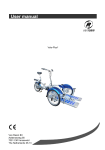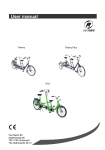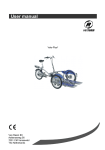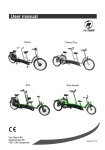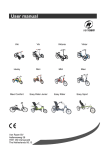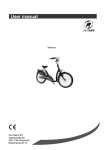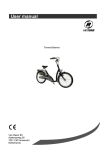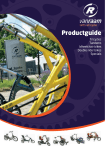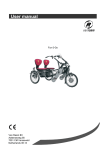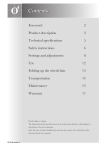Download User manual
Transcript
User manual O-Pair² Van Raam BV Aaltenseweg 56 7051 CM Varsseveld The Netherlands User manual O-Pair² 2 Contents Contents .................................................................................................................3 Contact details manufacturer ...................................................................................3 Conformity ..............................................................................................................3 Introduction .............................................................................................................4 Delivery...................................................................................................................4 Intended usage .......................................................................................................4 Safety measures .....................................................................................................5 Delivery inspection ..................................................................................................6 Adjustment of the bicycle .........................................................................................6 Accessories...........................................................................................................11 Before the first use ................................................................................................20 Technical details....................................................................................................22 Maintenance and adjustments to be done by owner................................................23 Repairs and maintenance to be done by dealer ......................................................25 Disposal................................................................................................................25 Handover/sale to a new owner...............................................................................25 Guarantee.............................................................................................................25 Frame number.......................................................................................................26 Contact details manufacturer Van Raam BV Aaltenseweg 56 7051 CM Varsseveld The Netherlands Tel. : +31 (0)315 257370 E-mail : [email protected] Internet : www.vanraam.nl Conformity Van Raam declares as manufacturer that the O-Pair² bicycle has been produced in accordance with the 93/42/EEG guidelines. User manual O-Pair² 3 Introduction This user manual gives important and necessary information about the use of your bicycle. We ask you to go through the manual thoroughly before using the bicycle. READ THOROUGHLY! Delivery - bicycle with possible packaging user manuals (s) pump foot support possible charger (s), depending on options Intended usage The bicycle is designed for normal use on level and solid ground. The usual bicycle caution should always be taken into consideration. At the same time all safety instructions as described in this manual should be complied with explicitly. Also the local traffic rules should always be complied with. All other use, including damage or physical injuries due to this, are not the manufacturer's responsibility. User manual O-Pair² 4 Safety measures • Ensure the bicycle is in good condition each time before using it. • Check before each ride that the brakes are in order. • Check the lights and reflectors. • Regularly check whether all screw joints are tight. • Regularly check whether the wheels, the handlebars and the saddle are secure. • Make sure there is sufficient air in the tyres. • Only use the bicycle on a solid and level surface. • Make sure that wide trousers or lose hanging clothing don’t get caught in the chain, spokes or pedals. • Do not use a pressure washer or a steam cleaner for the cleaning of the bicycle. • Use the parking brake if you or your passenger is getting on or off the bike. • Never drive without a passenger. This will cause instability of the bike and will lead to dangerous situations. User manual O-Pair² 5 Load The maximum load should not be exceeded. See information in the index of technical details on page 22. By permitted load we mean the total load, including the load on the luggage rack. Make sure that the permitted load on the luggage rack is not exceeded. Damaged or worn out parts The replacement and repair of parts (frame, forks, illumination, brakes, drive mechanism and the handle bars) should always be performed by a dealer. If not, the guarantee ceases to be valid and you will be personally responsible in the event of possible damage. Specific safety parts should always be replaced by new parts! Delivery inspection Check the delivery immediately after receiving it. In the event of damage or incomplete delivery we ask you to contact your dealer immediately. Adjustment of the bicycle Before using the bicycle, adjust it to the measurements of the cyclist and the passenger. This is of great importance, especially the saddle, the handlebars and the seat. If an optimal adjustment of the bicycle, as defined in the instructions, is not possible, you can contact your dealer for a fitting solution. The brakes are correctly adjusted as standard and can only be adjusted by the dealer during periodic maintenance. User manual O-Pair² 6 Saddle height When the cyclist is sitting on the bicycle and can put a foot on the pedal in the lowest position, the saddle height is correct. Adjust the saddle height in such a way that the leg is stretched but relaxed in that position. To adjust the saddle: 1. Open the quick-clamp [A]. 2. Slide the saddle to the correct height. 3. Close the quick-clamp. Make sure clothing cannot get caught in the clamp! [B] [A] If the clamp closes too easily, the clamping force is too low. In this case, open the clamp and tighten the nut (B) a bit more. If a lot of force is necessary to close the clamp, the nut should be loosened slightly. Do not pull out the saddle pin further than the marking. The tube will not go into the shank deep enough and will risk coming off. This can lead to serious injuries. User manual O-Pair² MIN INSERT 7 Handle bar height The height of the handle bars affects the comfort of the ride. It determines the pressure on the hands and the position of the back. Determine your own most comfortable height by using the bike. 1. 2. To adjust the handle bars: 1. Slightly loosen the screw by using an Allen key. 2. Slide the handle bars to the correct height and tighten the screw very firmly again. Do not pull out the handle bars further than the mark. Otherwise the tube will not be deep enough in the shaft and will risk coming off, which can lead to serious injuries. Position handle bars You can tilt the handle bars. This influences the distance from the handle bars to the upper body. Determine your own most comfortable position by using the bike. To tilt the handle bars: 1. Slightly loosen the screw with an Allen key. 2. Put the handle bars in the desired position and then tighten the screw very firmly again. User manual O-Pair² MIN INSERT 2. 1. 8 Steering damper The steering damper affects the stability during steering. By adjusting the screw, steering gets more rigid and stability will increase. Determine your own most comfortable setting for using the bike. Backrest chair Adjust the position of the backrest and the side support of the passenger. Start with the height of the backrest and armrests. To adjust these: 1. Loosen the nut on the upper bracket slightly by using a socket wrench. Loosen the two screws of the lower bracket slightly with an Allan key. 2. Adjust the backrest. The backrest is adjusted correctly if the passenger can easily rest with the lower arms on the arm rests and the upper ones straight down. Tighten the nut and screws again. 2. 1. 1. Next, adjust the backrest in the desired position. To do this: 1. Loosen the nut of the upper bracket slightly by using a socket wrench. 2. Turn the backrest, so that the passenger is sitting comfortably. Tighten the nut again. At last, adjust the side supports. To do this: 3. Loosen the four screws slightly on both sides using a socket wrench. 4. Turn the side supports to the body, in such a way that the passenger is sitting most comfortably. Tighten the screws again. User manual O-Pair² 2. 4. 1. 3. 9 Chair foot support Adjust the position of the passenger’s foot support. To do so: 1. First determine if the foot support is in the correct location. This is depending on the length of the passenger’s leg. By loosening the knob, the support can be taken out of the bracket and attached again one hole further. 2. There is another alternative for adjustment if it is not possible for these adjustments to find the correct position. Both bracket plates can be mounted one hole to the front or one hole to the back. To do this: Loosen the screws completely with an Allen key and move the plates to the desired position. Tighten the screws again. 3. To adjust the position of the foot support: Slightly loosen the screw of the foot support and put the foot support in the desired position in such a way that the passenger is sitting most comfortably. Tighten the screw again. 4. There is another alternative for adjustment if it is not possible for these adjustments to find the correct position. The foot support can be mounted one hole to the front or one hole to the back. To do this: Loosen the screws completely with a socket wrench and move the foot support to the desired position. Tighten the screws again. User manual O-Pair² 10 Waist belt chair Wrap the belt around the body and buckle it. Push the red button to unfasten the belt. Set the belt for the passenger by: 1. Unfastening the belt. 2. Pull the belt until it fits around the body of the passenger. Then buckle it. 2. 1. Accessories Depending on your order, you can use the accessories as described below. 2. Head rest To set the head rest: 1. Slightly loosen the nuts of the head rest with a socket wrench. 2. Position the head rest. Height, depth and angle can be adjusted at the same time. Then fasten the nuts again. 1. 1. 2. Adjust the seat depth To adjust the seat depth of the chair to the passenger: 1. Slightly loosen both nuts with a spanner. 2. Slide the seat so it fits the legs of the passenger. Fasten the nuts again. 1. User manual O-Pair² 11 Adjust the seat width The width of the chair can be adjusted to the passenger (A). Also adjust the supports to the front or to the back (B) so the passenger can rest comfortably on the supports. To adjust this: 1. Slightly loosen the four nuts with a socket wrench. 2. Slide the supports so they fit the body of the passenger. Then fasten the nuts again. 2. [B] [A] 1. Four- and five-point belt Wrap the belt around the body and buckle it. Push the red button to unfasten the belt again. To use the five-point belt, one side of the waist belt is slipped through the loop of the lap belt. Belts for children are adjusted over the side supports and then through the upholstery. For adults, the belts are adjusted over the chair. Belt for children User manual O-Pair² Belt for adults 12 Adjust the belt to the passenger by: 1. Un-buckle the belt. 2. Tighten the belt till it fits the body of the passenger. Then buckle it. Belt for adults 1. 2. Belt for children 1. 2. The child’s belt slides through the clamp on the front side of the back, behind the upholstery. Remove the upholstery and slip the belt through the clamp. User manual O-Pair² 13 Dividable frame The wheelchair can be separated from the bicycle part, so you can also go for a walk. To disconnect the wheelchair: 1. Use the parking brake by pressing the left brake (A) and securing the brake with the pellet (B). 2. Remove the grip (with the gear) from the handle bars. Push the pellet of the small spring so the grip can be removed from the handle bars. 3. Hang the grip together with the brake handle on the luggage rack or other suitable parts. 4. Remove the (extra) loose grip from the holder and place it on the handle bars. Push the pellet of the small spring to slide the grip on the handle bars. Make sure the small spring is secured in the grip. 5. Lower the support wheel by pulling out the knob. 6. Remove the safety pin. [B] [A] 1. 2. 3. 4. 6. 5. User manual O-Pair² 14 7. Optional: If you have an electric motor, loosen the cables. 8. Lift up the handle [A]. Loosen the clamp [B] and pull back the handle again. Slowly lower the wheelchair to the front on the nose-wheel. 9. Remove the bicycle part from the coupling. Caution: This is heavy. Hold the frame firmly with both hands. 10. Place the rear end on the stand. To assemble the bicycle again, follow these steps in reverse order. 7. [A] [B] 8. 9. 10. User manual O-Pair² 15 Folding the back rest To fold the back rest: 1. Slightly loosen the fastener handle. 2. Push the pin until the handle bars are released. 3. Pull out the handlebars from the tube. 4. Now fold the back rest to the front. 3. 1. 2. Notice that the cables are not bent when folding! User manual O-Pair² 4. 16 Electric motors The bicycle can be supplied with an electric motor. There are 2 types available. Accelerator: The electric motor is operated by using the accelerator. By using the cockpit you start the motor and determine the power of the motor. This motor accelerates and drives with a speed up to 6 km/h maximum. For more speed the cyclist has to pedal as well. Pas-Vario: The electric motor is operated by the cockpit. With this cockpit you switch the engine on/off and you can also determine the power of the motor. This motor only supports the cycling and does not accelerate. Use of the cockpit (same in both types): Press one of the buttons, 1, 2 or 3 to start the electric motor. With these buttons you can determine the power of the motor, also during cycling. With the red button you shut down the system. If the system is not used, it will automatically shut itself down after a period of time. When walking backwards with the bicycle, always turn off the motor. User manual O-Pair² 17 Charging the battery: The charging point is situated behind the seat. To charge the battery: 1. First connect the charger plug to the charging point behind the seat. 2. Put the charger plug in the wall socket. 3. Depending on the state of the battery, it needs 4 to 12 hours to charge. The battery is completely charged when the green lamp lights up. 4. As soon as the battery is charged, first take the plug from the wall socket and then disconnect the charger from the bicycle. 1. 2. Depending on your order this charger is delivered. When charging, first connect the plug to the charging point on the bicycle and then put the plug in the wall socket! When charged, first take the plug from the wall socket and then disconnect the charger from the bicycle! User manual O-Pair² 18 The batteries can also be taken from the containers and charged somewhere else, indoors for instance. To do this: 1. Loosen the charge connector of the batteries from the charging point under the seat. 2. Undo the lock of the fastening device and open it. 3. Take the batteries from the containers. 4. Put the batteries down and connect the charge connector of the batteries to the connector of the charger. 5. Put the charger plug in the wall socket. The red light will light up. 6. Depending on the state of the battery it will take 4 to 12 hours to fully charge. 7. As soon as the battery is charged, first take the plug from the wall socket. 8. Then take the charge connector of the batteries from the connector of the charger. 9. Place the batteries back in the containers on the bicycle and lock the fastening devices. 10. Then, connect the charge connector of the batteries to the connector of the charging point again. 1. 3. 2. Beware: • Charge the battery until the green lamp lights up. • Never interrupt the charging process. • For the lifespan of the battery it is better to charge the battery when it is almost discharged. • It is damaging for the battery if it is not used for more than 2 months. In that case charge the battery every now and then. • The case of the charger may not be opened by the buyer. In the event of problems go to your dealer! • Only use the charger in non-humid indoor spaces. • Below 5 degrees Celsius the charger will not function properly. In that case it is advisable to charge the batteries indoors. 4. 5. Extra accessories are available at your dealer. User manual O-Pair² 19 Before the first use Illumination The lights work on batteries. Push the button to switch the lights on and off. Both lights have 2 modes; steady and flashing. The front light has rechargeable batteries. When the light on the lamp is red, the lamp must be charged. The lamp can be charged in the wall socket. To do this: 1. Push the pellet and slide the lamp out of the holding device. 2. Remove the cover from the lamp. 3. Put the lamp in the wall socket. The charge light on the lamp will be on. 4. As soon as the charge light turns off, the lamp is charged. To fully charge the lamp, leave it plugged in for another 6 hours, after the charge light has expired. For the lifespan of the batteries, we recommend charging the lamp once every 3 months, when not used for a longer period. User manual O-Pair² 1. 2. 3. 20 Parking brake Always use the parking brake if you park the bicycle and leave it behind. To operate the parking brake, squeeze the left brake [A] and lock it with the pin [B]. By squeezing the brake again it will unlock itself. [B] [A] Gears Standard the bicycle has 8 gears. The gears are used by turning the grip. Do not use the pedals when turning the grip. Option: When your bike has an electric motor, there are 6 gears. Check before every ride: • the brakes (including the parking brakes) • the tyre pressure • the illumination • that all parts are secure Contact your dealer and do not use your bicycle if you identify any irregularities! As with all mechanical parts, the bicycle is subject to wear and tear and high loading. If a component fails, it can lead to very dangerous situations. This can lead to damage or injuries to the user of the bicycle. Any form of tearing, scratching or changing of colour is an indication that the part should be replaced. User manual O-Pair² 21 Points of interest during cycling After you have adjusted the bicycle to the measurements of the cyclist and the passenger, you can start using the bike. The tricycle gives a very different ride experience than a bicycle with two wheels! Practice, in particular, with bends and braking, because a tricycle can react contrary to what you would expect. It may happen that the front wheel comes off the ground on the inside when going round a bend. To avoid this the rider leans towards the inside of the bend with his body. High speeds in the bends, driving on rough ground, and sharp bends can lead to the tricycle falling over! Important safety points for the cyclist • Go very carefully during the first ride. • When riding the bicycle hold both hands firmly on the handle bars and feet on the pedals. • Test the riding style of the bicycle on rough ground at moderate speed. This way the cyclist learns how to react to unexpected movements of the bicycle and the handle bars during use. • Explore how the tilting movements of the bicycle react to body posture. Tilt to the inside of the bend. • Small obstacles should be cycled over with appropriate speed. • Obstacles higher than 5 cm should be avoided. Technical details Length (cm) Width (cm) Boarding height (cm) Front wheel Back wheel Weight (kg) Max. load luggage rack (kg) Total max. load (kg) Brakes, front Brakes, back User manual O-Pair² 190 72 52 24“ 20“ From 40 20 220 Disk brakes Drum brakes / Rim brakes 22 Maintenance and adjustments to be done by owner Below you can find the instructions for maintenance and adjustments that you can do yourself on a regular basis, which will keep your bicycle in top condition. Cleaning The frame of the bicycle can be cleaned with a damp cloth. For areas that are dirtier you can use a mild detergent. The wheels can be cleaned with a damp brush with plastic hairs (not a wire brush!) The saddle, seat (except the upholstery) and the grips can be cleaned with mild soap and water. Do not use a pressure washer or a steam cleaner! Cleaning the upholstery of the seat The upholstery and the back rest of the seat are removable and can be cleaned. You can wash them in the washing machine at 40°C maximum. Inspection of the bicycle After 200 kilometres or after a period of 2 months the bicycle should be inspected. Check the brakes, the illumination and the spokes. Also check the tyre tread depth. This should be at least 1 mm. Worn out tyres or possible faulty parts should be replaced. Also check the parking brake. With the parking brake pulled up, the bicycle should not ride away with the cyclist. The right lubricant The chain should be cleaned and maintained at regular intervals (every 3 months approximately). Only use special chain grease or Tevlon spray. This is the only way to make sure that the chain will run smoothly, will stay water resistant and will not rust. Wipe the chain with a cloth, treat it with grease or spray and remove any excess lubricant with a rag. Other parts should not be treated with a lubricant. User manual O-Pair² 23 The correct tension of the chain The chain should not be too tight. It should hang loose. Without effort you should be able to move the chain up and down, half a centimetre approximately. To keep the chain tension correct, the back wheel axle is adjusted. Follow the instructions below: 1. Slightly loosen the nuts of the back wheel axle, so that it can move backwards and forwards. 2. Slightly loosen the nut of the bracket, so it can also move. 3. By tightening the adjusting nuts at both sides, the back wheel slowly moves backwards. Tighten the adjusting nuts in such a way that the chain is hanging loose, as described above. 4. At the same time, make sure that the wheel is straight and positioned in the centre of the frame, as illustrated. Not to the left or to the right. 5. Slightly tighten the nuts of the back wheel axle. 6. Check whether the chain tension is correct and whether the wheel is straight and in the centre of the frame. 7. Tighten all the nuts again. 1. 3. 2. 3. 4. 4. Checking the rim Due to the combined action of the brake and the rims, not only the brake lining but also the condition of the rim is important. For this reason the rim should be checked at regular intervals, for example when you inflate the tyres. The presence of fine cracks in the spoke punches or deformation of the rim when there is higher air pressure, indicate more serious wear and tear. In that case the rim should be replaced, because it can lead to loss of brake function or even a crack in the rim, which can lead to all kinds of dangerous consequences. User manual O-Pair² 24 Repairs and maintenance to be done by dealer It is recommended that the bicycle has a yearly inspection carried out by the dealer. In the event of technical trouble or faults, the bicycle should be taken to the dealer for repairs immediately. The replacing of safety-related components (especially frame, brakes, illumination, handle bars, front fork and actuation) should be performed by the dealer. If you still decide you want to replace components yourself, you are responsible for damage or harm due to incorrectly fitted components. Only use original spare parts, which you can buy at you dealer. If requested the dealer will make the necessary information on repair and maintenance available. Disposal If you want to dispose your bicycle, contact your dealer. You can also contact the local waste disposal company. They will dispose the bicycle according to the regulations of your town. Handover/sale to a new owner When you hand over your bicycle to a new owner it is important that you also hand over all necessary technical documentation so that the new owner can use the bicycle safely. Guarantee The guarantee is valid for all faults in the product, which are proven to be caused by material or manufacturing error. For our bicycles we give a guarantee of 5 years on the frame and the front fork. For the paint, all accessories and other parts (except wear parts) we provide a 2 year guarantee, as legally regulated. Beware! The guarantee as well as the product liability in general expires if the instructions stated in this manual are not followed. This is also the case if unauthorized maintenance is carried out or if technical changes or additions are made without permission of Van Raam. User manual O-Pair² 25 Frame number The frame number is printed on the sticker. This sticker is located on the frame, see the image below. Example sticker: Frame number Position of sticker: on the back of the saddle tube User manual O-Pair² 26


























